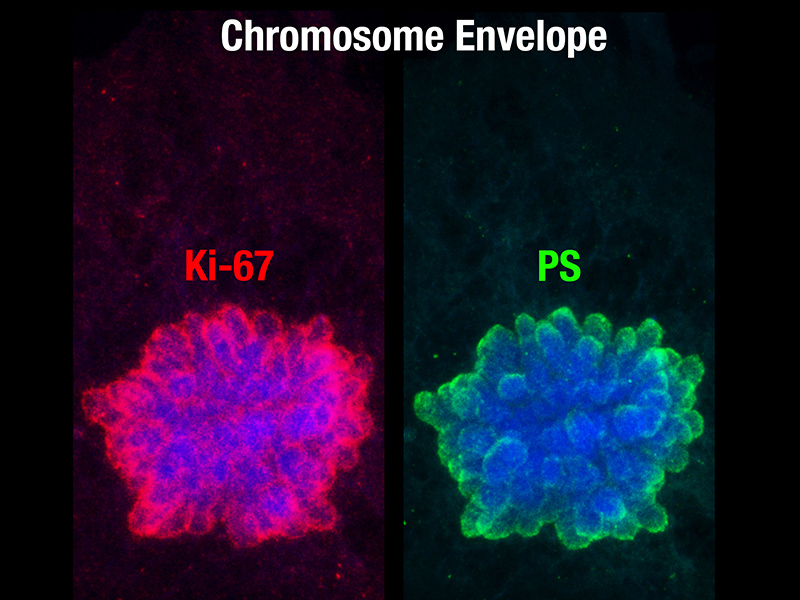Does “Chromosome Envelope” Exist in Addition to the Cell Membrane and Nuclear Envelope?
Dr. Hsueh, Yi-Ping and Wang, Ting-Fang - December, 2024
During eukaryotic mitosis, sister chromatids first undergo condensation and individuation before being equally segregated into the two daughter cells. This process varies across species. In most fungi (e.g., budding yeast), mitosis occurs in a “closed” manner, where the nuclear envelope (NE) remains intact throughout. In this scenario, the NE, cytoplasm, and cell membrane divide simultaneously, preventing mixing of cytoplasmic and chromosomal components.
In contrast, animal and plant cells undergo “open mitosis,” where the NE ruptures and disassembles before sister chromatid separation. After cell division, the NE reforms around the daughter nuclei. A critical question in open mitosis is how chromosomal components are protected from cytoplasmic exposure during the transient absence of the NE—a longstanding challenge in cell biology.
Dr. Hsiao-Tang Hu, using the trypsin-tyramide expansion microscopy (TT-ExM) method developed by Dr. Bi-Chang Chen and Mr. Ueh-Ting Wang, demonstrated for the first time that “chromosome envelopes (CE)” exist in mammalian cells. This structure, composed of nuclear non-histone proteins such as Ki-67, is regulated by phosphorylation through cyclin-dependent kinases (CDKs). Ki-67 facilitates the accumulation of phosphatidylserine (PS) and other lipids on the outer surfaces of mitotic chromosomes. The CE acts as a barrier, preventing the diffusion or penetration of cytoplasmic components into the interiors of mitotic chromosomes, offering a novel mechanism to maintain chromosomal integrity during open mitosis.
"Ki-67 and CDK1 Control the Dynamic Association of Nuclear Lipids with Mitotic Chromosomes"
Nuclear lipids play roles in regulatory processes such as signaling, transcriptional regulation, and DNA repair. In this report, we demonstrate that nuclear lipids may contribute to Ki-67-regulated chromosome integrity during mitosis. In COS-7 cells, nuclear lipids are enriched at the perichromosomal layer and excluded from intrachromosomal regions during early mitosis, but are then detected in intrachromosomal regions during late mitosis, as revealed by TT-ExM, an improved expansion microscopy technique that enables high-sensitivity, super-resolution imaging of proteins, lipids, and nuclear DNA. The nuclear non-histone protein Ki-67 acts as a surfactant to form a repulsive molecular brush around fully condensed sister chromatids in early mitosis, preventing the diffusion or penetration of nuclear lipids into intrachromosomal regions. Ki-67 is phosphorylated during mitosis by cyclin-dependent kinase 1 (CDK1), the best-known master regulator of the cell cycle. Both Ki-67 knockdown and reduced Ki-67 phosphorylation by CDK1 inhibitors allow nuclear lipids to penetrate chromosomal regions. Thus, both Ki-67 protein level and phosphorylation status during mitosis appear to influence the perichromosomal distribution of nuclear lipids. Ki-67 knockdown and CDK1 inhibition also lead to uneven chromosome disjunction between daughter cells, highlighting the critical role of this regulatory mechanism in ensuring accurate chromosome segregation. Given that Ki-67 has been proposed to promote chromosome individualization and establish chromosome-cytoplasmic compartmentalization during open mitosis in vertebrates, our results reveal that nuclear lipid enrichment at the perichromosomal layer enhances Ki-67’s ability to form a protective perichromosomal barrier (chromosome envelope), which is critical for correct chromosome segregation and maintenance of genome integrity during mitosis.

除了細胞膜(cell membrane)與細胞核套膜(nuclear envelope)外,染色體也有套膜(chromosome envelope)?
真核生物進行有絲分裂(mitosis)時,細胞核中成對的姊妹染色分體(sister chromatid pair),先進行「濃縮(condensation)」與「個別化(individualization)」,再經紡錘絲(spindle fiber) 引領,將姊妹染色分體平均分離到兩個子細胞,其過程在不同物種之間有所不同。
絕大多數的真菌細胞進行「封閉式有絲分裂(closed mitosis)」,成對的姊妹染色分體分離過程中,細胞核套模(nuclear envelope)不破裂消失,且隨細胞質(cytosol)與cell membrane同步進行分裂,因此細胞質成份與染色體成份不會混雜在一起。
動物與植物細胞則進行「開放式有絲分裂(open mitosis)」,nuclear envelope在成對的姊妹染色分體分離前破裂消失,待分裂成兩個子細胞後,再重新組成新的nuclear envelope。動植物細胞進行open mitosis時,如何區隔細胞質成份與染色體成份是細胞生物學研究領域仍懸而未決的重要課題。
胡曉棠博士利用本院應科中心陳壁彰老師與王月廷所開發的「胰蛋白酶與酪氨酰胺擴展顯微鏡(trypsin-tyramide expansion microscopy; TT-ExM)」技術,發現負責動物細胞染色體「個別化」的Ki-67蛋白質,在open mitosis時被主控細胞週期的週期素激酶(cyclin-dependent kinase; CDK)磷酸化後,可調控核内脂質成份,如磷脂醯絲胺酸(Phosphatidylserine,PS)和其他脂質分子,聚集在「個別化」的成對姊妹染色分體的表層,證明「染色體套膜(chromosome envelope)」存在,是細胞學重要發現。
Ki-67與結構類似的蛋白質目前只發現於動物細胞。在人類癌症診斷和治療過程中,Ki-67 常被用作判別腫瘤惡性程度的標記物,細胞分裂越快,Ki-67 表現量越高,但我們對其結構與生化機制瞭解仍甚少。
相關研究成果已於2024年12月18日以未校正版發表於「脂質」研究領域知名期刊Journal of Lipid Research ,它與Journal of Biological Chemistry都是美國生化與分子生物學會(American Soceity of Biochemistry and Molecular Biology)出版的專業學術期刊。